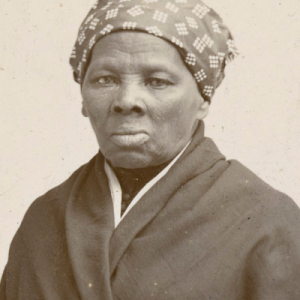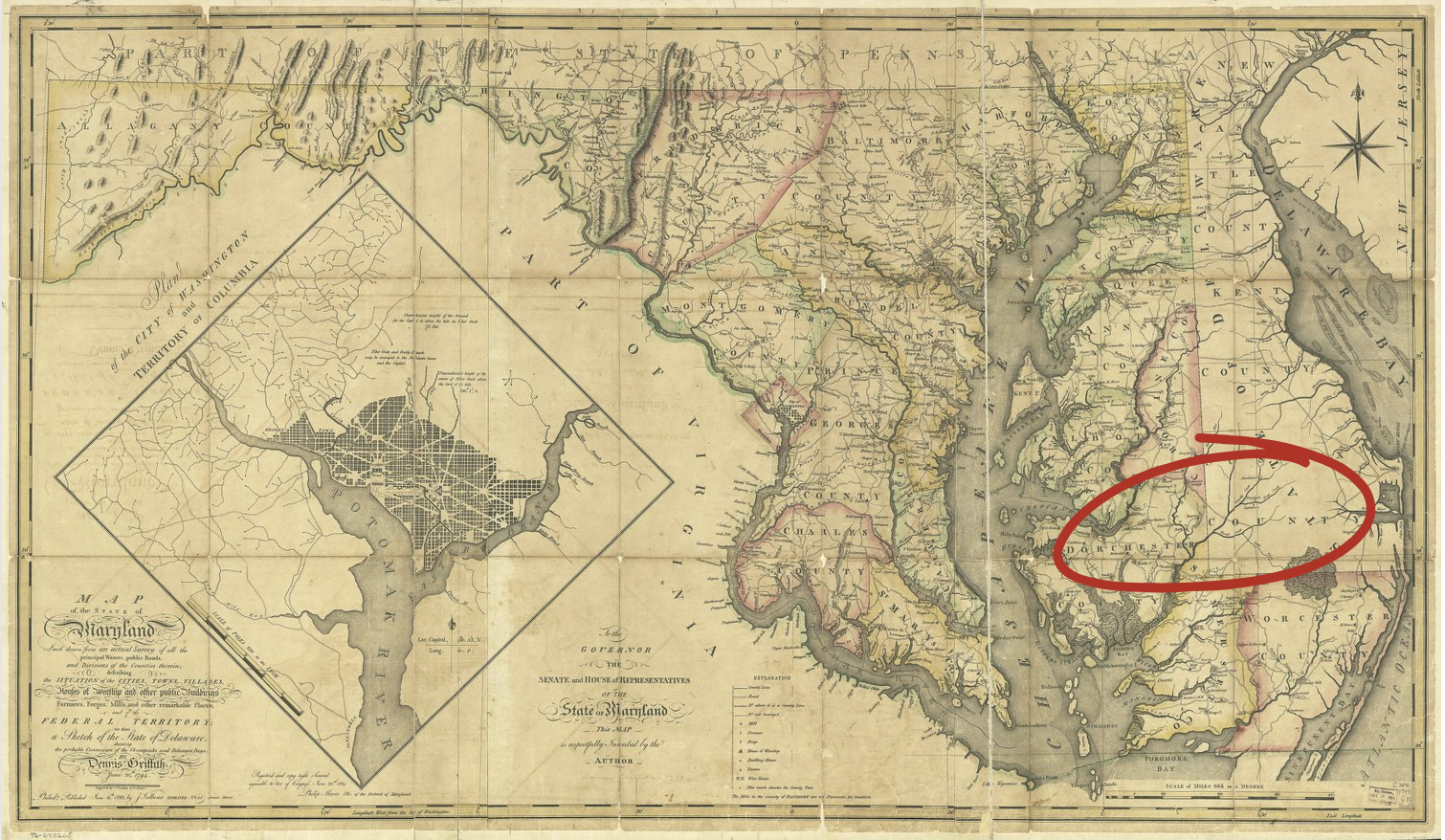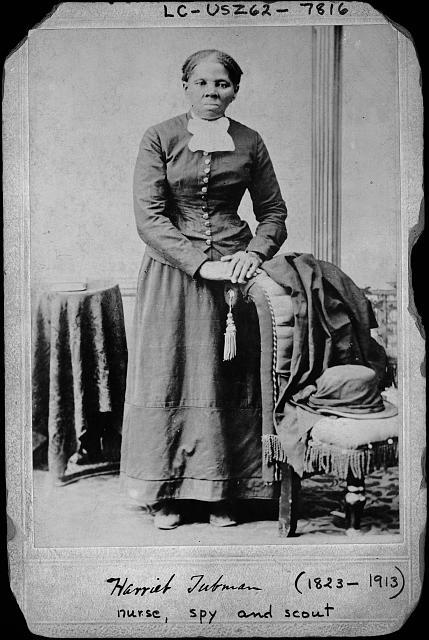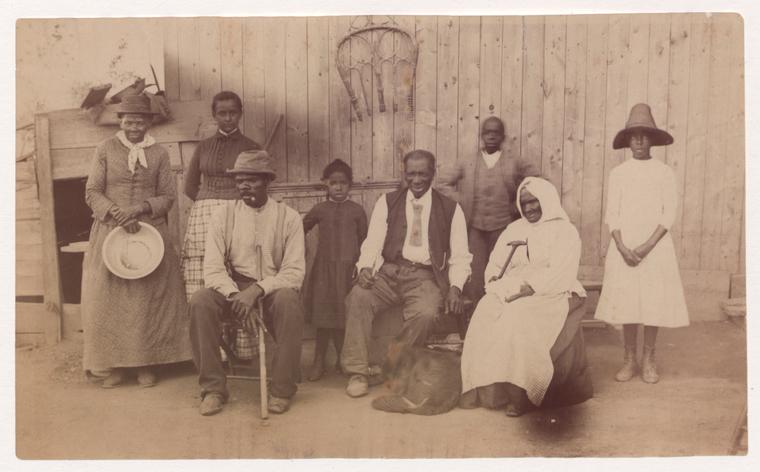Harriet Tubman

Tubman was born into slavery in 1822, and later escaped from Dorchester County, Maryland to Philadelphia where she lived as a freewoman
Once free, Tubman dedicated her life to the abolition of slavery as a conductor on the Underground Railroad. She brought approximately 70 enslaved African Americans to freedom in the north
Tubman remained a philanthropist well into her later years, founding the Home for Aged & Indigent Negroes and supporting women’s rights
"I had reasoned this out in my mind; there was one of two things I had the right to, liberty or death; if I could not have one, I would have the other.” – Harriet Tubman, 1886
Early Life
Born Araminta Ross (and affectionately called "Minty") in March of 1822 to parents Harriet (Rit) Green Ross and Benjamin Ross, Tubman was one of nine children. The Ross family were enslaved in Dorchester County, Maryland. Chattel slavery determined that Black people were property that were bought and sold. The children of enslaved women were also considered enslaved, regardless of whether their fathers were enslaved or not. Such was the case for Tubman and her siblings as Benjamin was free, but Rit was not (University at Buffalo). The Ross’ enslaver, Edward Brodess, did not allow the family to remain together and worked to split them up through the assignment of work. Separated from Benjamin Ross at a young age, Rit, Araminta and her siblings worked on a different farm owned by the Brodesses in Bucktown, Maryland (NPS n.d.).

In 1828 at the age of six, Brodess rented out Tubman at his whim to provide childcare for nearby overseers. Compensation for her work would go to Brodess and time periods for how long she would be rented out would vary. This work separated her from her mother and siblings for extended periods of time. Tubman's life would change forever at the age of 13. In 1835, while she was running errands at a local store, she witnessed another enslaved person’s attempted escape (Owens 2022). She refused to assist the freedom seeker's enslaver in capturing the fugitive. As the enslaver became desperate in their attempt to recapture the freedom seeker, he threw a two pound weight. Rather than hitting the intended target, he struck Tubman in the back of the head and fractured her skull.
She teetered between life and death. Her mother Rit nursed Tubman back to health as much as she could given their limited resources (NPS n.d.). After the incident, physical pain became a consistent part of Tubman’s life. She experienced chronic pain from headaches and uncontrollable bouts of seizures, which Tubman herself referred to as “sleeping spells," (PBS 2022). Historians now know that Tubman had narcolepsy, which is a “chronic neurological disorder that affects the brain's ability to control sleep-wake cycles” (National Institute of Neurological Disorders and Stroke n.d.).
Tubman’s place in disability history is often overlooked. It is important to note that narcolepsy was a prominent part of both her identity and story. Vivid visions of freedom came to her while experiencing these seizures (PBS 2022). As a result of her visions, her disability is often associated with her religiosity. However, Tubman’s dedication to her faith and her experience with chronic pain hold equal weight. Both elements were key in her determination to seek liberation for the enslaved. Historian Deidre Cooper Owens spoke to the importance of Tubman’s disability in her essay "Harriet Tubman’s Disability and Why it Matters." Cooper-Owens highlighted that, “she offered up a version of freedom where a disabled Black woman sat at the center of it, where Black women were liberators, and where liberation was communal and democratic” (Owens 2022).
Journey to Freedom
The pain of separation from her family and the cruelty of slavery never left Tubman. Forced back to the fields immediately after her injury, Tubman recounted: “there I worked with the blood and sweat rolling down my face til I couldn’t see” (Wickenden 2021). She became determined to find some sense of autonomy wherever she could, despite the confines of enslavement (NPS n.d.). She negotiated with her enslaver to select her own work assignments. He agreed so long as she paid him a yearly fee. From then on, Tubman hired herself out on her own terms.
With new tasks came the exploration of new geographic areas. Dorchester County’s environment is marshland (NPCA n.d.). As such, the duties given to the enslaved in this area were unique to the landscape of Maryland’s Eastern Shore. Tubman became familiar with the intricacies of the environment through these tasks. Down the line, her familiarity with Dorchester County would be key in her journey to freedom.
In an unexpected turn of events, one assignment required her to work alongside her father in the timber fields. Not only did this allow her to spend time with him despite years of separation, but also to work alongside Black sailors. As regular travelers along the East Coast, these men were well connected. They shared their knowledge of the surrounding areas with Tubman and assisted her in tapping into a network of those also seeking liberation (Wickenden 2021). It was around this time that she met her future husband, freedman John Tubman. The couple married in 1844 when Tubman was 22 years old. Upon their union, she changed her name from Araminta “Minty” Ross, to Harriet (likely after her mother) Tubman (NPS n.d.).
Tubman cherished moments spent with her father and her time as a newlywed. However, her enslaver Brodess struggled financially and found himself in debt in 1849. He decided to sell more of his enslaved workers as a financial solution. Tubman discovered that Brodess’s financial troubles were likely to lead to the sale of her and her brothers, Ben and Henry (Wickenden 2021). Even Brodess’s death in 1849 did not alleviate Tubman’s fear of the sale and Tubman sought to make her dreams of freedom a reality. She saw her future clearly, detailing to biographer Sarah Hopkins Bradford what she envisioned as she crossed the Mason-Dixon line that separates Pennsylvania, Maryland, Delaware, and West Virginia: “and on the other side of that line were green fields, and lovely flowers, and beautiful white ladies who stretched out their arms to me over the line” (Tubman, 1869).
Making use of her wealth of knowledge gained over the years, Tubman set her sights on escaping to Philadelphia. The Abolitionist Movement, which was prominent in the city, meant she was sure to find allies and like-minded confidants (University at Buffalo n.d.). After developing a route, the journey with her brothers began. While on the journey, the trio caught word that Eliza Broddess, Brodess’s widow, placed an ad in the paper calling for their return (Balkansky 2020). Tubman’s brothers decided to return to the plantation for fear of capture and subsequent punishment. Not the slightest bit discouraged, the visions that came to Tubman during narcoleptic bouts assured her she would be free (Wickenden 2021). She pressed onward alone, guided to Pennsylvania by the stars.
The Moses of Her People: Conducting the Underground Railroad
With the help of abolitionists along the way, Tubman journeyed from the Brodess’ farm in Maryland to Pennsylvania. In Philadelphia, she made connections with abolitionists, namely William Still, a conductor on the Underground Railroad (Larson 2004). Tubman learned more about the Underground Railroad from Still. Often misunderstood as a railroad with tracks and trains, the Underground Railroad (UGRR) actually refers to various safehouses in which abolitionists provided sanctuary for freedom seekers. “Conductors” led the journeys to freedom, while “Station Masters” hosted freedom seekers within their homes, churches, or other safe spaces. The more Tubman learned, the more her desire to see her family free grew. She decided to return for them in 1850.
After a successful first trip in which she brought both family and friends to freedom, she became a Conductor on the UGRR. She succeeded in her second journey as well and, on her third in 1851, Tubman returned for her husband, John. She quickly discovered that he thought she was dead and had remarried. John’s new wife was pregnant. Though heartbroken, Tubman’s commitment to freedom knew no bounds. She offered to take the couple to freedom, but John refused.
In 1850, Congressional passage of the Fugitive Slave Act changed the calculus for Conductors like Tubman. The Act “stipulated that it was illegal for any citizen to assist an escaped slave and demanded that if an escaped slave was sighted, he or she should be apprehended and turned in to the authorities for deportation back to the ‘rightful’ owner down south. Any United States Marshall who refused to return a runaway slave would pay a hefty penalty of $1,000,” (University at Buffalo n.d.). Many freedom seekers opted to flee to Canada instead of the northern US as a result. Tubman conducted eleven trips from Maryland to St. Catherines, Ontario, Canada between 1850 and 1860. All of these journeys–19 in total– over the years made Tubman a hero, with many African Americans–both free and enslaved–dubbing her “Moses” after the biblical figure (Library of Congress 1998 and Balkansky 2020).
While widely celebrated within her own community, Tubman was infamous among enslavers. Many called for her capture with bounties upwards of $40,000, which would be approximately $1,573,056.41 in today’s dollars. Between 1850 to 1860, Tubman brought approximately 70 individuals (including her parents, Rit and Ben) to freedom. Tubman spoke proudly of her accomplishments and famously stated, “I never ran my train off the track and I never lost a passenger” (Prescod-Weinstein 2022).
General Tubman: The Union Spy
In 1857, after working to free her parents, Tubman initially brought them to Canada with her but ultimately settled in Auburn, New York. Auburn was a hotbed of abolition and felt like an ideal place for Tubman and her family to settle. Frances Seward, abolitionist wife of Senator (and later Secretary of State under President Abraham Lincoln) William H. Seward, offered Tubman land in Auburn (University at Buffalo n.d.). This further encouraged the family to stay. Though Tubman had her freedom, the fight for the liberation of the enslaved still called to her.
In 1857, she met abolitionist John Brown. Brown was outspoken in his support of antislavery and, though unpopular among white southerners, his efforts were largely supported by those in the North. Tubman and Brown formed a close friendship, with Brown dubbing her “General Tubman” (NPS n.d.). She once claimed to have seen him in many of her narcoleptic dreams before meeting him. The pair worked together, including on Brown’s plans for the raid on Harpers Ferry, (now West) Virginia; Tubman provided her geographical expertise and recruited formerly enslaved people to assist in the raid. While planned as a way to steal guns and start a revolt to free enslaved people across the South, the raid ultimately ended in failure. An army unit, led by future Confederate General Robert E. Lee, captured Brown and put him on trial for "treason, murder, and inciting a slave rebellion" (NPS n.d.). Brown was hung shortly thereafter. Tubman was not in attendance at his hanging due to illness.
In April 1861, the American Civil War broke out over the issue of slavery. Tubman saw an opportunity to get involved, enlisting in the Union (Northern) Army as a nurse where she cared for wounded soldiers with natural remedies (University at Buffalo n.d.). In 1863, Tubman took on the role of a scout and organized a group of spies. She recruited enslaved people interested in assisting the Union. Tubman helped Colonel James Montgomery coordinate the Combahee River Raid in South Carolina, which aimed to “harass whites and rescue freed slaves” (University at Buffalo n.d.). The raid was wildly successful with Montgomery’s troops burning down many plantations and freeing approximately 750 enslaved people. (NPS n.d.). With their newfound freedom, many of the formerly enslaved men opted to join the Union’s fight against the Confederacy (the South). To date, Tubman is recognized as the first woman in US history to both plan and lead a military raid. In June 2021, the Army inducted her into the Military Intelligence Corps (Lacdan 2023).

Later Life and Legacy
During her time with the Union Army, Tubman met her second husband, Nelson Davis. The couple married in 1869 in Auburn, NY where he, Tubman, and her freed family members (one of which was their adopted daughter, Gertie), would live out their days (NPS n.d.). Nelson built the family a home, which still stands as of 2024. It is also in Auburn where Tubman founded the Home for the Aged, an institution that provided care for those with “paralysis, epilepsy, and those with vision impairment and blindness,” (Shoot 2021).

A staunch supporter of the suffrage movement, Tubman worked alongside various upstate-NY based suffragists, such as Lucretia Mott, Susan B. Anthony, and Elizabeth Cady Stanton. The interests of abolitionists were aligned closely with those of suffragists, with both movements concerned with autonomy and freedom. Later in life, Tubman attended various women’s rights conferences (Balkansky 2020). She also collaborated with the AME Zion Church, helping them raise money to build their church in Auburn (NPS n.d.). As collaborative partners, the church then supported Tubman’s dream of making the Home for the Aged a reality.
Nelson Davis passed away in 1888. In his absence, Tubman continued to dedicate her final 25 years to philanthropic efforts. In 1913, at the age of 91, Harriet Tubman died of pneumonia in the Home for the Aged & Indigent Negroes. In her final words, Tubman called upon her faith and made reference to John 14:3 in the Bible. She stated, “I go away to prepare a place for you, that where I am you also may be” (Larson 2004, p. 289). She was laid to rest in the Fort Hill Cemetery in Auburn.
Of service to her community until the very end, Harriet Tubman’s legacy remains relevant. In 2024, the United States Mint launched the 2024 Harriet Tubman Commemorative Coin Program. On Veteran's Day that same year, the Governor of Maryland recognized Tubman as "one of the greatest authors of the American story" and posthumously named Tubman a one-star brigadier general (Dvorak 2024). Continued discussions about and homages to Tubman stems from her powerful narrative of taking control of her own destiny and ultimately forging a path for others. She is celebrated not only for the hundreds of enslaved that she freed over the course of her lifetime, but for all of those who still look to her story for guidance. Just as she looked to the North Star to carry her to freedom, her work and values remain a guiding light to many to continue onward–no matter how harrowing the path ahead.
 Primary Source Analysis Strategies
Primary Source Analysis Strategies
Caption: This map highlights in red Dorchester County, Maryland. Located right along the coast, it has direct access to water.
Analysis Questions:
-
At first glance, what do you notice about the map? Now, examine the map closely. What do you notice that you did not see the first time?
-
Who is the intended audience of this map?
-
Spot Dorchester County. What does being able to locate it on a map make you wonder?
Caption: Tubman is seen posing for a portrait sometime between 1871 and 1876, expression neutral while she rests her hands on a chair. The bottom of the image reads “Harriet Tubman (1822-1913)” and “Nurse, spy and scout”.
Analysis Questions:
-
What is the first thing you notice when looking at this image? Why do you think you might have gravitated towards that first?
-
Based on the events mentioned in the biography between 1871 and 1876 (when this image was thought to be taken), why might Tubman have had this portrait taken?
-
What do you notice about her appearance (her attire, hair, etc)?
-
The caption “nurse, spy and scout” omits words such as “conductor, abolitionist, formerly enslaved” etc. Do you believe Tubman would have agreed with the caption? If she dictated it herself, why do you think she might have wanted to be known by those three labels?
Caption: Tubman (on the far left) is photographed alongside her husband Nelson Davis, adopted child Gertie, and various other family members. This photograph was taken in Auburn, NY on the Tubman-Davis property.
Analysis Questions:
-
When examining this photo of Tubman surrounded by family, what questions come to mind?
-
Reflect on Tubman’s journey to freedom. What is the significance of this image of her photographed with so many of her family members?
-
In comparison to the previous images of Tubman, what differences do you notice in how she appears in this photograph?
Educator Notes
"Teacher's Guide Analyzing Primary Sources," Library of Congress
This resource outlines different lenses that students can examine through primary resources through. There is no specific order to use the columns in. The questions students develop through their examination are meant to encourage further research and curiosity. Educators can then propose other activities (as outlined in the resource) that help students further contextualize different - but related - primary sources
"Primary Source Analysis Tool," Library of Congress
This is a blank version of the previous link. Educators can create their own specific sample questions (most likely based on the medium of the primary source to have students answer in each column, or simply have students fill out this document with the guidance of the original document.
"Teacher's Guide Analyzing Maps," Library of Congress
Similar to the first resource, this document specifically focuses on how to analyze maps. The questions highlighted in each column still use the “Observe, Reflect, Question” model, but allow students to further hone in on the unique features of maps - such as the one featured in this biography.
- Lacdan, Joe. “Army Honors Female Combat Pioneer, Renowned Abolitionist.” www.army.mil. August 25, 2023. https://www.army.mil/article/269360/army_honors_female_combat_pioneer_renowned_abolitionist.
- Balkansky, Arlene. Harriet Tubman: Conductor on the Underground Railroad. June 16, 2020. https://blogs.loc.gov/headlinesandheroes/2020/06/harriet-tubman-conductor-on-the-underground-railroad/
- Dvorak, Petula. Harriet Tubman Becomes a One-Star General in Maryland, 160 Years Late. November 11, 2024. https://www.washingtonpost.com/dc-md-va/2024/11/11/harriet-tubman-brigadier-general-civil-war-underground-railroad/
- “Harriet Tubman’s Story.” National Parks Conservation Association. n.d. https://www.npca.org/articles/2162-harriet-tubman-s-story.
- Harriet Tubman Timeline. University at Buffalo. n.d. http://math.buffalo.edu/~sww/0history/hwny-tubman.html.
- “Tubman.” National Parks Service. n.d. https://www.nps.gov/hatu/learn/historyculture/htubman.htm.
- Larson, Kate Clifford, Bound for the Promised Land: Harriet Tubman, Portrait of an American Hero. New York, Ballantine, 2004.
- London, Nicole, Stanley, Nelson and Christopher, Haley. 2022. Harriet Tubman: Visions of Freedom. [San Francisco, California, USA]: PBS.
- Owens, D. C. Harriet Tubman’s disability and why it matters. Ms. Magazine. February 10, 2022. https://msmagazine.com/2022/02/10/harriet-tubman-disability-democracy/
- Prescod-Weinstein, Dr. Chanda. “Harriet Tubman, Astronomer Extraordinaire.” Ms. Magazine, February 3, 2023. https://msmagazine.com/2022/02/03/harriet-tubman-astronomer-underground-railroad-north-star-nasa/.
- Shoot, B. (2021). The brain injury that helped end slavery. Folks. n.d. https://folks.pillpack.com/brain-injury-helped-end-slavery/
- “The African American Odyssey: A Quest for Full Citizenship Abolition, Anti-Slavery Movements, and the Rise of the Sectional Controversy.” Library of Congress, February 9, 1998. https://www.loc.gov/exhibits/african-american-odyssey/abolition.html.
- “When John Brown Met Harriet Tubman.” National Parks Service. n.d. https://www.nps.gov/hafe/learn/historyculture/when-john-brown-met-harriet-tubman.htm.
- Wickenden, Dorothy. “Liberty or Death: On the Prophetic Visions and Unflinching Will of Harriet Tubman.” Literary Hub, March 31, 2021. https://lithub.com/liberty-or-death-on-the-prophetic-visions-and-unflinching-will-of-harriet-tubman/.
- http://www.math.buffalo.edu/~sww/0history/hwny-tubman.html
Image Citations
- Griffith, Dennis, James Thackara, and J Vallance. Map of the State of Maryland laid down from an actual survey of all the principal waters, public roads, and divisions of the counties therein; describing the situation of the cities, towns, villages, houses of worship and other public buildings, furnaces, forges, mills, and other remarkable places; and of the Federal Territory; as also a sketch of the State of Delaware shewing the probable connexion of the Chesapeake and Delaware Bays. [Philadelphia, J. Vallance, 1794] Map. https://www.loc.gov/item/76693265/.
- Lindsley, Harvey B, photographer. Harriet Tubman, full-length portrait, standing with hands on back of a chair. , ca. 1871. [Between and 1876] Photograph. https://www.loc.gov/item/2003674596/.
- Powelson, Benjamin F, photographer. Portrait of Harriet Tubman / Powelson, photographer, 77 Genesee St., Auburn, New York. New York, 1868. [Auburn, N.Y.: Benjamin Powelson, or 1869] Photograph. https://www.loc.gov/item/2018645050/.
- United States Mint. Harriet Tubman 2024 Proof Silver Dollar Coin. 2024. https://catalog.usmint.gov/harriet-tubman-2024-proof-silver-dollar-coin-24CL.html?cgid=harriet-tubman-commemorative-coins#start=1
- Schomburg Center for Research in Black Culture, Photographs and Prints Division, The New York Public Library. "Harriet Tubman; Gertie Davis; Nelson Davis; Lee Cheney; "Pop" Alexander; Walter Green; Sarah Parker; and Dora Stewart " New York Public Library Digital Collections. https://digitalcollections.nypl.org/items/510d47df-793f-a3d9-e040-e00a18064a99
MLA – Dawson, Shay. "Harriet Tubman-Davis." National Women's History Museum. National Women's History Museum, 2024. Date accessed.
Chicago - Dawson, Shay. “Harriet Tubman-Davis" National Women's History Museum. 2024. www.womenshistory.org/education-resources/biographies/harriet-tubman.
- Bradford, Sarah Hopkins. Harriet, the Moses of Her People. Chapel Hill: The University of North Carolina Press, 2012. muse.jhu.edu/book/19228.
- Hobson, Janell, Michelle D. Commander, Dr. Chanda Prescod-Weinstein, Dr. Kate Clifford Larson, Deirdre Cooper Owens, Dr. Edda L. Fields-Black, Janell Hobson, et al. “The Harriet Tubman Bicentennial Project.” Ms. Magazine, February 1, 2023. https://msmagazine.com/tubman200/.
- Library of Congress. Research guides: Harriet Tubman: Topics in Chronicling America: Search Strategies & Selected Articles. N.d. https://guides.loc.gov/chronicling-america-harriet-tubman/selected-articles.

This biography is sponsored in part by the Library of Congress Teaching with Primary Sources Eastern Region Program, coordinated by Waynesburg University. Content created and featured in partnership with the TPS program does not indicate an endorsement by the Library of Congress.
For further information or questions, please contact [email protected].




